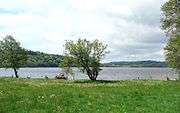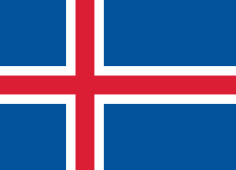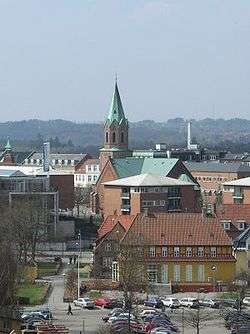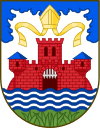Silkeborg
| Silkeborg | ||
|---|---|---|
|
View of Silkeborg church (built 1877), looking north-west | ||
| ||
 Silkeborg Location in Denmark | ||
| Coordinates: 56°11′00″N 9°33′06″E / 56.18333°N 9.55167°ECoordinates: 56°11′00″N 9°33′06″E / 56.18333°N 9.55167°E | ||
| Country | Denmark | |
| Region | Central Denmark (Midtjylland) | |
| Municipality | Silkeborg | |
| Area | ||
| • City | 864.89 km2 (333.94 sq mi) | |
| Elevation | 31 m (102 ft) | |
| Population (2014) | ||
| • City | 43,158 | |
| • Density | 50/km2 (130/sq mi) | |
| • Urban | 90,016 | |
| Time zone | Central Europe Time (UTC+1) | |
| Postal code | 8600 | |
| Area code(s) | (+45) 89 | |
| Website | Silkeborg Kommune | |
Silkeborg (Danish pronunciation: [ˈselɡəˌbɒːˀ]) is a Danish town with a population of 43,158 (1 January 2014).[1] Silkeborg is the seat of the council of Silkeborg municipality (90,016 inhabitants as of 2015) and is also part of the East Jutland metropolitan area (ca. 1.2 million inhabitants).[2]
Silkeborg is located in the middle of the Jutlandic peninsula, slightly west of the geographical centre of Denmark. The city is situated at the Gudenå River in the hilly and lush landscape of Søhøjlandet, surrounded by Denmark’s largest forest district and a great number of lakes. The lakes between Silkeborg and Ry that are linked by the Gudenå, are known collectively as Silkeborgsøerne (the Silkeborg lakes).[3] The city is divided north and south by the lake of Silkeborg Langsø, which at the eastern side of the city, resolves into the Gudenå River.
History
Silkeborg was the site of a castle, a monastery and a farming estate, established in the 15th century, some 6 km from Alling Abbey.[4] The modern grew around the Drewsen og Sønner paper mill, established in 1844. Silkeborg Papirfabrik (Silkeborg Paper mill) was located near the Gudenå River where Silkeborg castle once stood, in order to exploit the river as a source of energy for the mill, as a resource for paper production and as a transportion route. Michael Drewsen, regarded as the founder of the city, was responsible for the daily management of the mill. Today a statue of Michael Drewsen stands in front of the old city hall in the town square. A commission to establish Silkeborg as a trading venue was set up in 1845, and the site grew into a small settlement, from a population of 30 in 1844 to 556 in 1850 and to 1,204 in 1855. A municipal council and parish was established in 1855. The railway was built in 1871. Silkeborg was given the status of market town (købstad) in 1900. Population was recorded as 7,228 in 1901, and as 8,792 in 1911. During the German occupation of Denmark, the Gestapo turned the Silkeborg Bad (Silkeborg Baths), which served at that time as the municipal sanatorium, into its Danish headquarters.[5] The remnants of German bunkers can still be seen today, one of these bunkers is now a public museum.
Geography
Silkeborg is located in region known as Søhøjlandet (lit.: the lake-highland) in mid-eastern Jutland, regarded as one of the most beautiful areas in Denmark. The landscape consists mostly of lakes, extensive woodlands (such as the Silkeborg Forests) and some of the highest points in Denmark, including Himmelbjerget. It is also one of the most expensive areas in Denmark in which to reside, and the neighbouring village of Sejs is known for its large mansions and lakeside villas at Brassø.
Economy
For many years the paper mill (Silkeborg Paprfabrik) was the most prominent business in the city, but during the 1990s it suffered financial difficulties.[6] In 1993, the German corporation, Drewsen Spezialpapiere, bought the mill, but in 2000 decided to close it. A project of urban renewal turned the industrial area closest to the city centre partly into a new commercial district with a hotel, a cinema, a concert hall, restaurants and cafés; and partly into a new residential neighbourhood with modern apartment buildings.
The city has a large number of car dealerships, and is also the headquarters of Jyske Bank, Denmark's third largest bank.[7]
Main sights
- Silkeborg Museum: The oldest preserved building in the city is Silkeborg Manor constructed in 1767. This building is today Silkeborg Museum where you can see the naturally mummified corpse of the Tollund man, who lived during the 4th century BC.[8]
- City square: The old city square (Torvet) is the centre of Silkeborg and is together with the surrounding streets a pedestrian area. The city square is surrounded by the Hotel Dania (Silkeborgs oldest hotel, founded in 1848).[9] the Old Town Hall and the city church (Silkeborg Kirke). On the city square there are two fountains and the bronze statue of Michael Drewsen, the founder of Silkeborg. On Saturdays the weekly market is located here.
- Hjejlen: The world’s oldest steamboat[10] Hjejlen is one of the tour boats that take off from the Silkeborg harbor.
- Aqua: The freshwater aquarium Aqua (distinct from the Danish pop group) is one of the region’s best visited sights. In the indoor aquarium and outdoor animal park, fish and animals of the Danish nature can be examined.[11] The exhibited animals are fish, birds, otters, beavers and raccoons.
- Museum Jorn: Silkeborg was the home city of COBRA painter Asger Jorn, and many of his most famous paintings can be seen the Museum Jorn, Silkeborg.[12]
- Silkeborg Bad: The former sanatorium, Silkeborg Bad served as headquarters for the Nazi German Gestapo during WWII. Today a Bunker Museum is located in the beautiful park and in the old sanatorium buildings houses today an art museum. Many of the museums sculptures can also be seen in the park for free. The natural spring, Arnakkekilden, is located in the park next to the lake Ørnsø. Danish brewery Carlsberg has used the water for bottled spring water for many years.[13]

- Himmelbjerget: The third highest point in Denmark is called Himmelbjerget and is not exactly located in the city, in fact not even in Silkeborg County. However, it remains a sight closely linked to the city as tour boats all summer goes from the harbor of Silkeborg to the hills of Himmelbjerget.
- The lake fountains: The fountains in Silkeborg Langsø are among the largest in northern Europe[14] and are a landmark of the city and the lakes. The fountains are located in the lake just outside the city hall and were constructed in 1970. The fountains have a magnificent light show and after dark the water cascades changes color. The change in color has a program of 30–40 minutes.
- Indelukket: The marina and recreation area Indelukket is located close to Museum Jorn, and is a well attended area during the summer. There is a park, a restaurant and Denmark’s oldest miniature golf course.[15]
Yearly events
- The SCC country music festival has been an annual event since 1986. The festival takes place in Indelukket the second weekend of August.[16]
- Riverboat Jazz Festival takes place every year in the last weekend of June. The festival is not connected to a single location in Silkeborg but instead various stages can be found around the city most prominently at the harbor and the city square.[17]
- Hede Rytmer (English: Hot rhythms) is an annual rock and pop festival held in Indelukket in the beginning of the summer. The playing acts are often famous Danish bands, but occasionally also international names. In 2011 Boney M., 10CC and The Orchestra, the former Electric Light Orchestra played at the 3-day festival.[18]
- Silkeborg Reggae Festival, also known as Raggapak, was a reggae festival.[19]
Regatta
Since 1899 Silkeborg has hosted an event called "Ildfestregatta", which means "fire party regatta".[20] Currently this event is held every third year, the last of which occurred on 13–16 August, 2014. During the regatta the city streets are closed to traffic in the evening, becoming temporary venues where live music is performed, merchandise is sold from stalls, and an amusement park operates. The houses next to the Gudenå River are decorated with coloured lamps, as are the many boats that enter the port at this time.

On Wednesday, Thursday and Friday at 0:00 p.m., there is an unofficial Danish fireworks championship. On each day, a different company puts on a fireworks display and the winner is announced on Saturday. On Saturday evening, the winner from three years before puts on a major firework show sponsored by Silkeborg Municipality. Today the fireworks are fired from a huge raft on the lake of Silkeborg just next to the town hall, but earlier the show was done from the roof of the old paper mill.
Sports
The two most popular sports in Silkeborg are football and handball:
- The city’s professional football team, Silkeborg IF, plays in the highest tier of danish football, the Danish Superliga. The team has won the league trophy once, in 1994; the Danish cup in 2001; and the UEFA Intertoto Cup in 1997. Silkeborg IF plays its home matches at Silkeborg Stadion, renamed Mascot Park after the company Mascot, manufacturer of work clothes, which bought the rights to the stadium name. It is located close to the city centre and has a capacity of 10.000 people.
- Silkeborg’s professional handball team is BSV, the name formed by a combination of the names of the towns Bjerringbro, Silkeborg, and Voel. The team is a part of the Danish Handball League, and plays its home matches at Jysk Arena, previously known Silkeborg Hallerne, a sports centre northeast of the city centre. The ladies handball team Silkeborg-Voel usually plays its home matches in Voel Hallerne about 10 km from Silkeborg.
- The motor racing circuit Jyllands-Ringen is located about 5 km from the city centre in the town area Resenbro. The circuit is 2.3 km long and is a part of the DTC, (Danish Touringcar Championship) and the Scandinavian Touring Cap Championship.
- Silkeborg IF Cykling is a cycling club based in Silkeborg. In 2004, the club created an élite amateur team, named Team Designa Køkken. Its biggest accomplishment came in 2008 when rider Jakob Fuglsang won Danmark Rundt, aka the Tour of Denmark.
- Silkeborg has a ski resort, with natural snow in winter, and also a nylon track that allows for year-round skiing. The ski resort is located in Gjern about 15 km from downtown Silkeborg.[21]
Media
Silkeborg is served by two conspicuous media; a newspaper and a radio station. The oldest of them is the daily newspaper Midtjyllands Avis founded in 1857[22] as Silkeborg Avis. It is the sixth oldest newspaper in Denmark and was founded when the town of Silkeborg had only existed for 11 years. In many years the paper had its own paper press, but today it is printing at Jyllands-Postens facilities.
Today Midtjyllands Avis is owned by the concern Silkeborg Avis A/S. This concern is also the joint owner of the radio station Radio 1 (formerly known as Radio Silkeborg), a commercial radio station broadcasting online and on airwaves in the middle of Jutland. The radio station has focus on popular music and local news. The sister station Silkeborg Guld focuses on older Danish and English music only interrupted by commercials. The newspaper and the radio station are located at Papirfabrikken.
On 16 August 2013 it was announced that Radio Silkeborg was handed over to the Radio ABC Group. As a consequence five employees were let off but the transmission would continue on the same frequency.[23]
Transportation
- Road Silkeborg is connected by highways to Aarhus, Herning, Horsens, Randers and Viborg. A new motorway was completed in September 2016 connecting Silkeborg to Aarhus and Herning. Regional buses to the surrounding cities are located at the train station. The local transport consists of 12 local bus routes serving the downtown area and suburbs.
- Rail The main station, Silkeborg Station, is served by the railway line between Aarhus and Herning, which is currently operated by Arriva Danmark, The former railway links to Horsens and Langå were closed in the 1960s, leaving the city connected to only east- and westbound rail traffic.
- Water The Gudenå River was for many years an important transport link for passengers and cargo, but today passenger transport along the river is only available for tourists during the summer.
- Airport Midtjyllands Lufthavn is the closest airport, located 40 km North West of Silkeborg. The airport offers several daily flights to the Danish capital Copenhagen.
Notable people
- Alphabeat, pop band.
- Jesper Asholt, actor.
- Lars Bak, professional road bicycle racer.
- Jakob Fuglsang, professional road bicycle racer.
- Thomas Bjørn, golfer.
- Johannes Fibiger, recipient of 1926 Nobel Prize in Physiology or Medicine.
- Asger Jorn, artist.
- Simon Kvamm, singer.
- Harald Madsen, variety artist, actor in popular Danish silent movies
- Morten Ørum Madsen, golfer.
- Henrik Pedersen, former footballer
- Jesper Skibby, former professional road bicycle racer.
- Peter Sørensen, footballer and coach.
- Ole Tøpholm, radio host and Danish commentator at the Eurovision Song Contest.
- Kasper Dolberg, professional footballer
- Rose Marie Kirkeby Kampmann, award winning designer and researcher
Notable mentions in popular culture
- In the 1973 film The Day of the Jackal, the main character dons a number of aliases throughout the story. One of them is a Danish schoolteacher named Per Lundqvist, who claims to hail from the town of Silkeborg.
- In the opening episode of season six of Parks and Recreation Heidi Klum's character receives an award for women in government, representing Silkeborg.
- Inspired by an Asger Jorn print in a band member's home in Dublin, Ireland, Silkeborg is now also the name of an Irish band[24]
Friendship cities
-
 Árborg, Iceland
Árborg, Iceland -
 Arendal, Norway
Arendal, Norway -
 Banja Luka, Bosnia and Herzegovina
Banja Luka, Bosnia and Herzegovina -
 Corona, United States
Corona, United States -
 Giżycko, Poland
Giżycko, Poland -
 Kaiserslautern, Germany
Kaiserslautern, Germany -
 Kalmar, Sweden
Kalmar, Sweden -
 Savonlinna, Finland
Savonlinna, Finland
References
- ↑ BEF44: Population 1.January by urban areas database from Statistics Denmark
- ↑ BLST Archived 25 February 2009 at the Wayback Machine.
- ↑ "Silkeborgsøerne". WikiSilkeborg (in Danish). Silkeborg Arkiv. Retrieved 26 July 2015.
- ↑ The history of Silkeborg, silkeborgshistorie.dk, Retrieved 8 October 2013.
- ↑ , Hverdagen under besættelsen, Retrieved 8 October 2013.
- ↑ , Silkeborg Papirfabrik, Retrieved 8 October 2013.
- ↑ , About Jyske Bank, Retrieved 8 October 2013.
- ↑ , Silkeborg Museum, Retrieved 8 October 2013.
- ↑ , Hotel Dania, Retrieved 8 October 2013.
- ↑ , Hjejlen - Oldest steam boat in the world, Retrieved 8 October 2013.
- ↑ , Aqua - main page, Retrieved 8 October 2013.
- ↑ , Museum Jorn - main page, Retrieved 8 October 2013.
- ↑ , About Arnakkekilden at silkeborg bad, Retrieved 8 October 2013.
- ↑ , Silkeborg Langsø fountains, Retrieved 8 October 2013.
- ↑ , Story of Indelukkets minigolf, Retrieved 8 October 2013.
- ↑ SCC official site, Silkeborg country music festival, Retrieved 9 October 2013.
- ↑ Riverboat Jazz Festival official site, Riverboat in Silkeborg, Retrieved 9 October 2013.
- ↑ Hede Rytmer 2011, Midtjyllands Avis, Retrieved 9 October 2013.
- ↑ Official website
- ↑ , Gegatta, Retrieved 8 October 2013.
- ↑ Skiing in Denmark, Skiurlaub-Infos, Retrieved 11 October 2008.
- ↑ "Other Activities". JP/Politikens Hus. Retrieved 15 February 2015.
- ↑ Radio Silkeborg closes, Retrieved 17 November 2013.
- ↑ Silkeborg
External links
| Wikimedia Commons has media related to Silkeborg. |
| Wikivoyage has a travel guide for Silkeborg. |
- Official municipality website
- www.silkeborg.com – tourist information
- Hjejlen.com
- Byopgørelsen (inhabitants cities) latest publications
- Museum Jorn, Silkeborg


